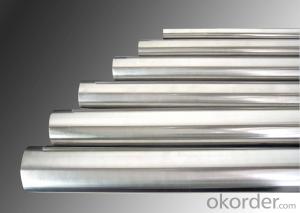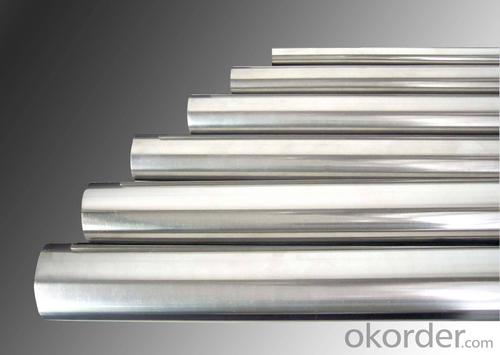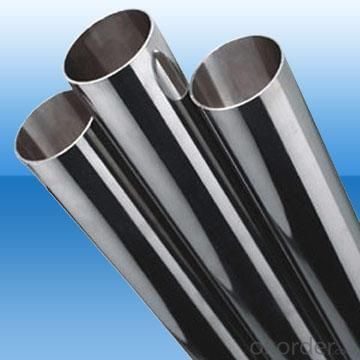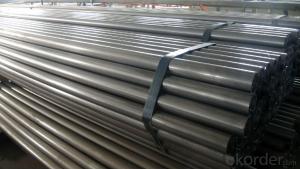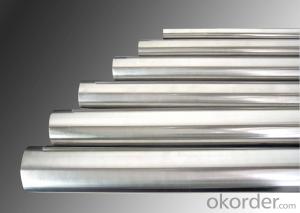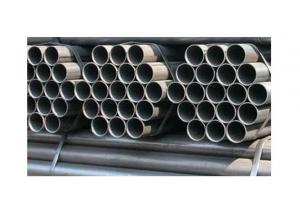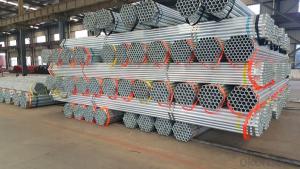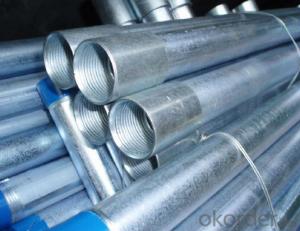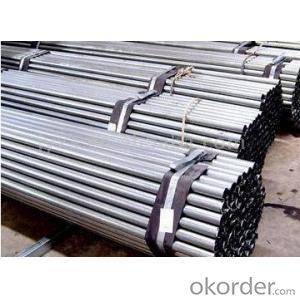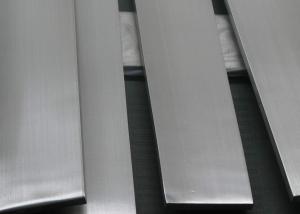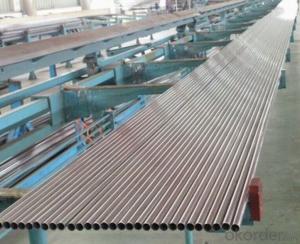Galvanized Cold Drawn Stainless Steel Pipe With 2 Plastic Caps
- Loading Port:
- Tianjin
- Payment Terms:
- TT OR LC
- Min Order Qty:
- 35 m.t.
- Supply Capability:
- 5000 m.t./month
OKorder Service Pledge
OKorder Financial Service
You Might Also Like
Specification
Galvanized Cold Drawn Stainless Steel Pipe With 2 Plastic Caps
1.Structure of Galvanized Cold Drawn Stainless Steel Pipe:
Seamless pipe is formed by drawing a solid billet over a piercing rod to create the hollow shell. As the manufacturing process does not include any welding, seamless pipes are perceived to be stronger and more reliable. Historically seamless pipe was regarded as withstanding pressure better than other types, and was often more easily available than welded pipe.
2.Main Features of the Galvanized Cold Drawn Stainless Steel Pipe:
• High manufacturing accuracy
• High strength
• Small inertia resistance
• Strong heat dissipation ability
• Good visual effect
• Reasonable price
3.Galvanized Cold Drawn Stainless Steel Pipe Specification:
Standard | GB, DIN, ASTM ASTM A106-2006, ASTM A53-2007 |
Grade | 10#-45#, 16Mn 10#, 20#, 45#, 16Mn |
Thickness | 8 - 33 mm |
Section Shape | Round |
Outer Diameter | 133 - 219 mm |
Place of Origin | Shandong, China (Mainland) |
Secondary Or Not | Non-secondary |
Application | Hydraulic Pipe |
Technique | Cold Drawn |
Certification | API |
Surface Treatment | factory state or painted black |
Special Pipe | API Pipe |
Alloy Or Not | Non-alloy |
Length | 5-12M |
Outer Diameter | 21.3-610mm |
Grade | 20#, 45#, Q345, API J55, API K55, API L80, API N80, API P110, A53B |
Standard | ASME, ASTM |
1) Material:20#(ASTM A 106/A53 GRB.API5LGRB,GB),45#,16Mn,10#.
2) Specification range:OD:21.3-610mm,WT:6-70mm,length:6-12m or according to the requirement of clients.
3) Excutive standards:GB,ASME API5L.ASTM A 106/A53,Despite of the above standards,we can also supply seamless steel pipe with standard of DIN,JIS,and so on,and also develop new products according to the requirements of our clients!
4) Surface:black lacquered,varnish coating or galvanized.
5) Ends:Beveled or square cut,plastic capped,painted.
6) Packing:bundles wrapped with strong steel strip,seaworthy packing.
4. Packing and Delivery:
Packaging Details: | seaworthy package,bundles wrapped with strong steel strip |
Delivery Detail: | 50-60days after received 30%TT or Original LC |
5. FAQ of Galvanized Cold Drawn Stainless Steel Pipe
How is the quality of your products?
Our products are manufactured strictly according to national and internaional standard, and we take a test on every pipe before delivered out. If you want see our quality certifications and all kinds of testing report, please just ask us for it.
Guaranteed: If products’ quality don’t accord to discription as we give or the promise before you place order, we promise 100% refund.
②How about price?
Yes, we are factory and be able to give you lowest price below market one, and we have a policy that “ for saving time and absolutely honest business attitude, we quote as lowest as possible for any customer, and discount can be given according to quantity”,if you like bargain and factory price is not low enough as you think, just don’t waste your time.Please trust the quotation we would give you, it is professional one.
③Why should you chose us?
Chose happens because of quality, then price, We can give you both.Additionally, we can also offer professional products inquiry, products knowledge train(for agents), smooth goods delivery, exellent customer solution proposals.Our service formula: good quality+good price+good service=customer’s trust
SGS test is available, customer inspection before shipping is welcome, third party inspection is no problem.
Any question, pls feel free to contact us !
6.Galvanized Cold Drawn Stainless Steel Pipe Images:
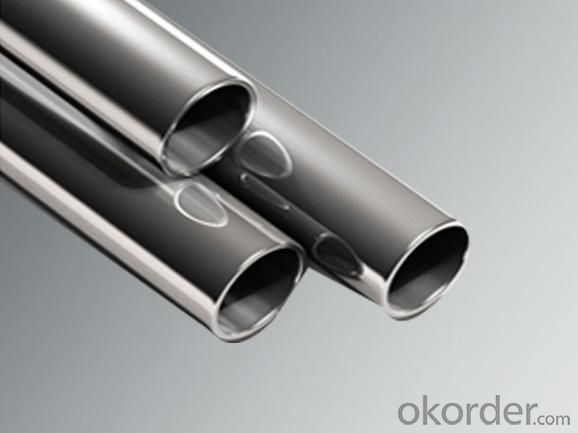
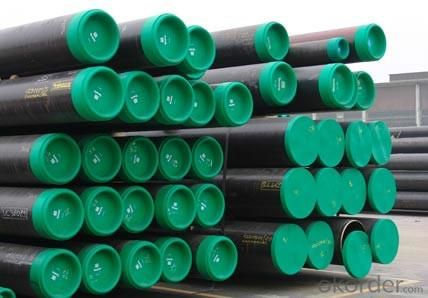
7. Company Information:
CNBM International Corporation (CNBM International) is the most important trading platform of CNBM Group Corporation, a state-owned company under the direct supervision of State-owned Assets Supervision and Administration Commission of the State Council.
Since 2004, the trading volume of CNBM International has been doubled in 5 successive years owing to the support of superior corporations and effort of all staff. Meanwhile, we have established strategic partnerships with hundreds of domestic manufacturers and sound business relations with clients from over 120 countries. Currently, we have wholly-owned overseas subsidiaries and branches in 5 countries with a view to realize localization, which also represents an essential progress in our globalization target.
In line with the business, CNBM International launched E-business platform Okorder.com.Our goal is to transform CNBM International into the global leading brand in building materials industry within 3 to 5 years through innovation and reform, by strengthening the overall management of supply chain, developing and cultivating both domestic and overseas market, improving the procedure and information system, enhancing the ability to organize resources and to provide value-added services under a professional team and a learning organization.
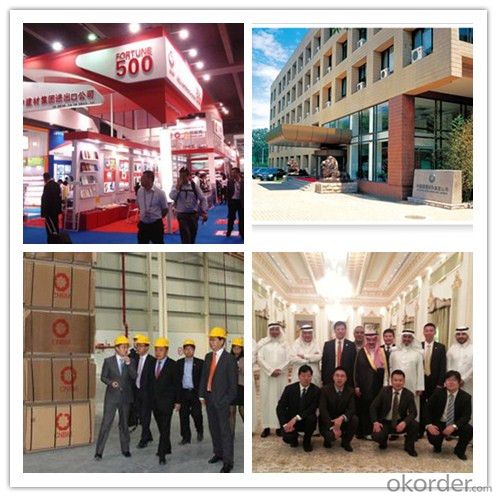
- Q: Can stainless steel pipes be heat treated?
- Yes, stainless steel pipes can be heat treated. Heat treatment processes such as annealing, solution annealing, and stress relieving can be applied to stainless steel pipes to improve their mechanical properties, such as strength, hardness, and corrosion resistance.
- Q: Can stainless steel pipes be used for gas applications?
- Yes, stainless steel pipes can be used for gas applications. Stainless steel is highly resistant to corrosion and can withstand high temperatures, making it a suitable material for transporting gases. Additionally, stainless steel pipes have excellent strength and durability, ensuring the safety and reliability of the gas system. They are commonly used in industrial, commercial, and residential applications where gas is being transported. However, it is essential to ensure that the stainless steel pipes being used meet the specific requirements and standards for gas applications to ensure proper installation and performance.
- Q: Can stainless steel pipes be insulated with polyvinyl chloride?
- Yes, stainless steel pipes can be insulated with polyvinyl chloride (PVC). PVC is a commonly used material for pipe insulation due to its excellent thermal properties and resistance to moisture, chemicals, and corrosion. It is a cost-effective solution that provides insulation to prevent heat loss or gain in the pipes, protecting them from extreme temperatures and reducing energy consumption. PVC insulation is available in various forms, such as pre-formed tubes or sheets, which can be easily installed on stainless steel pipes. However, it is important to ensure that the PVC insulation is compatible with stainless steel and meets the necessary industry standards to avoid any potential issues or degradation of the pipes.
- Q: Does stainless steel pipe belong to hardware?
- Hardware refers to gold, silver, copper, iron, tin, five kinds of metal materials, carbon steel and stainless steel is iron upgrade, naturally belongs to the hardware.
- Q: How do stainless steel pipes compare to HDPE pipes?
- Stainless steel pipes are known for their exceptional durability, corrosion resistance, and high temperature tolerance. They are widely used in various industries, including construction, oil and gas, and food processing. On the other hand, HDPE pipes offer excellent flexibility, lightweight design, and chemical resistance. They are commonly used in plumbing and irrigation systems. In terms of cost, stainless steel pipes are generally more expensive than HDPE pipes. Overall, the choice between stainless steel and HDPE pipes depends on specific application requirements, budget constraints, and desired characteristics such as strength, flexibility, and resistance to corrosion or chemicals.
- Q: What is the difference between 409 and 316 stainless steel pipes?
- The composition and intended use are what differentiate 409 and 316 stainless steel pipes. 409 stainless steel is categorized as ferritic stainless steel, containing more chromium but less nickel than 316 stainless steel. This means that 409 stainless steel is less resistant to corrosion and oxidation. However, it is still suitable for applications that require moderate levels of corrosion resistance, such as automotive exhaust systems and heat exchangers. On the contrary, 316 stainless steel is classified as austenitic stainless steel, with higher amounts of both chromium and nickel. Because of its composition, it provides excellent corrosion resistance, even in demanding environments. Therefore, it is commonly used in applications where superior resistance to corrosion is necessary, such as marine environments, chemical processing plants, and medical equipment. To summarize, the main distinctions between 409 and 316 stainless steel pipes are their composition and corrosion resistance. 409 stainless steel is appropriate for applications with moderate levels of corrosion resistance, while 316 stainless steel is the preferred choice for applications that demand superior corrosion resistance in harsh environments.
- Q: How do you prevent stainless steel pipes from corroding?
- There are several measures that can be taken to prevent corrosion in stainless steel pipes: 1. The selection of the appropriate grade of stainless steel is crucial. Each grade has varying levels of corrosion resistance, so it is important to choose a grade that is suitable for the specific environment in which the pipes will be used. For environments that are more corrosive, it is recommended to use higher grades such as 316 stainless steel. 2. Proper installation and maintenance are essential. Ensuring that the pipes are installed correctly with the appropriate gaskets, seals, and fittings will prevent any gaps or leaks that could allow moisture or corrosive substances to enter. Regular inspections and maintenance should be conducted to identify and repair any damage or potential sources of corrosion. 3. Keeping the pipes clean and dry is important. Regular cleaning will remove any contaminants or corrosive substances that may have accumulated. It is important to avoid using harsh chemical cleaners that can harm the protective oxide layer on the surface of the stainless steel. Additionally, prolonged exposure to water or moisture should be avoided to keep the pipes dry and prevent corrosion. 4. The application of protective coatings can provide an additional layer of protection against corrosion. There are specific coatings or paints designed for stainless steel that act as a barrier, preventing direct contact between the stainless steel and corrosive substances. 5. In highly corrosive environments, cathodic protection can be utilized. This involves the use of sacrificial anodes or impressed current systems to divert the electrical current away from the pipes, thus protecting the stainless steel from corrosion. By following these preventive measures, the risk of corrosion in stainless steel pipes can be significantly reduced, leading to a longer lifespan for the pipes.
- Q: What is the maximum temperature for stainless steel pipes?
- The maximum temperature for stainless steel pipes can vary depending on the specific grade of stainless steel being used. However, in general, stainless steel pipes can typically withstand temperatures ranging from 1000 to 1600 degrees Fahrenheit (537 to 871 degrees Celsius).
- Q: Are stainless steel pipes suitable for hydraulic applications?
- Stainless steel pipes are indeed suitable for hydraulic applications. Renowned for their outstanding resistance to corrosion, stainless steel proves ideal for hydraulic systems that may encounter different fluids. With their impressive strength and durability, stainless steel pipes can withstand the high pressure and temperature conditions commonly found in hydraulic systems. Moreover, these pipes offer exceptional dimensional stability, maintaining their shape and integrity even during extreme operating conditions. Thanks to their corrosion resistance, stainless steel pipes boast a longer service life compared to alternative materials, reducing the necessity for frequent replacements and maintenance. All in all, stainless steel pipes represent a trustworthy and effective option for hydraulic applications.
- Q: How do stainless steel pipes differ from other types of pipes?
- Stainless steel pipes differ from other types of pipes in several ways. Firstly, stainless steel pipes are known for their exceptional corrosion resistance. The presence of chromium in stainless steel forms a protective layer on the surface, preventing rust and corrosion even in harsh environments. This makes stainless steel pipes highly durable and long-lasting compared to other types of pipes. Secondly, stainless steel pipes have high strength and are able to withstand significant pressure and temperature variations. This is particularly important in industries where pipes are subjected to high levels of stress or extreme conditions. Stainless steel pipes can handle these conditions without compromising their structural integrity. Additionally, stainless steel pipes are highly versatile and can be used in a wide range of applications. They are commonly used in industries such as oil and gas, chemical processing, food and beverage, pharmaceuticals, and construction. Stainless steel pipes can handle different types of fluids, including corrosive substances, acids, and gases, making them suitable for various industries and applications. Furthermore, stainless steel pipes have excellent hygienic properties. They are easy to clean and maintain, making them ideal for applications where cleanliness is crucial, such as in the food and beverage industry or in medical facilities. The smooth surface of stainless steel pipes also prevents the accumulation of bacteria and other contaminants. Lastly, stainless steel pipes are aesthetically pleasing and offer a modern and sleek appearance. This makes them suitable for architectural and decorative purposes, such as in building structures, handrails, or furniture. In summary, stainless steel pipes differ from other types of pipes due to their corrosion resistance, high strength, versatility, hygienic properties, and aesthetic appeal. These characteristics make stainless steel pipes a popular choice in various industries and applications.
Send your message to us
Galvanized Cold Drawn Stainless Steel Pipe With 2 Plastic Caps
- Loading Port:
- Tianjin
- Payment Terms:
- TT OR LC
- Min Order Qty:
- 35 m.t.
- Supply Capability:
- 5000 m.t./month
OKorder Service Pledge
OKorder Financial Service
Similar products
Hot products
Hot Searches
Related keywords
